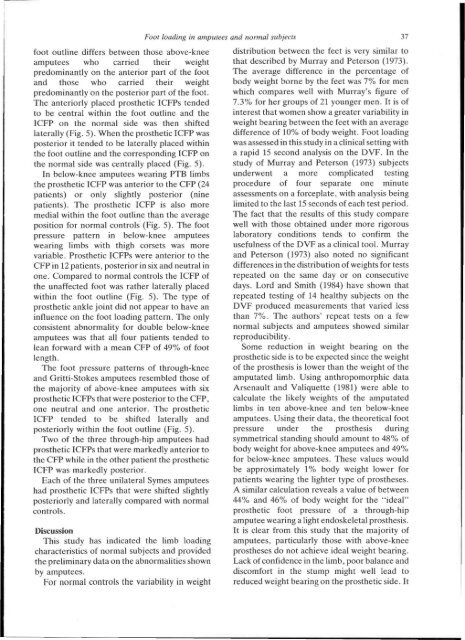View Complete Issue PDF
View Complete Issue PDF
View Complete Issue PDF
Create successful ePaper yourself
Turn your PDF publications into a flip-book with our unique Google optimized e-Paper software.
foot outline differs between those above-knee<br />
amputees who carried their weight<br />
predominantly on the anterior part of the foot<br />
and those who carried their weight<br />
predominantly on the posterior part of the foot.<br />
The anteriorly placed prosthetic ICFPs tended<br />
to be central within the foot outline and the<br />
ICFP on the normal side was then shifted<br />
laterally (Fig. 5). When the prosthetic ICFP was<br />
posterior it tended to be laterally placed within<br />
the foot outline and the corresponding ICFP on<br />
the normal side was centrally placed (Fig. 5).<br />
In below-knee amputees wearing PTB limbs<br />
the prosthetic ICFP was anterior to the CFP (24<br />
patients) or only slightly posterior (nine<br />
patients). The prosthetic ICFP is also more<br />
medial within the foot outline than the average<br />
position for normal controls (Fig. 5). The foot<br />
pressure pattern in below-knee amputees<br />
wearing limbs with thigh corsets was more<br />
variable. Prosthetic ICFPs were anterior to the<br />
CFP in 12 patients, posterior in six and neutral in<br />
one. Compared to normal controls the ICFP of<br />
the unaffected foot was rather laterally placed<br />
within the foot outline (Fig. 5). The type of<br />
prosthetic ankle joint did not appear to have an<br />
influence on the foot loading pattern. The only<br />
consistent abnormality for double below-knee<br />
amputees was that all four patients tended to<br />
lean forward with a mean CFP of 49% of foot<br />
length.<br />
The foot pressure patterns of through-knee<br />
and Gritti-Stokes amputees resembled those of<br />
the majority of above-knee amputees with six<br />
prosthetic ICFPs that were posterior to the CFP,<br />
one neutral and one anterior. The prosthetic<br />
ICFP tended to be shifted laterally and<br />
posteriorly within the foot outline (Fig. 5).<br />
Two of the three through-hip amputees had<br />
prosthetic ICFPs that were markedly anterior to<br />
the CFP while in the other patient the prosthetic<br />
ICFP was markedly posterior.<br />
Each of the three unilateral Symes amputees<br />
had prosthetic ICFPs that were shifted slightly<br />
posteriorly and laterally compared with normal<br />
controls.<br />
Discussion<br />
This study has indicated the limb loading<br />
characteristics of normal subjects and provided<br />
the preliminary data on the abnormalities shown<br />
by amputees.<br />
For normal controls the variability in weight<br />
distribution between the feet is very similar to<br />
that described by Murray and Peterson (1973).<br />
The average difference in the percentage of<br />
body weight borne by the feet was 7% for men<br />
which compares well with Murray's figure of<br />
7.3% for her groups of 21 younger men. It is of<br />
interest that women show a greater variability in<br />
weight bearing between the feet with an average<br />
difference of 10% of body weight. Foot loading<br />
was assessed in this study in a clinical setting with<br />
a rapid 15 second analysis on the DVF. In the<br />
study of Murray and Peterson (1973) subjects<br />
underwent a more complicated testing<br />
procedure of four separate one minute<br />
assessments on a forceplate, with analysis being<br />
limited to the last 15 seconds of each test period.<br />
The fact that the results of this study compare<br />
well with those obtained under more rigorous<br />
laboratory conditions tends to confirm the<br />
usefulness of the DVF as a clinical tool. Murray<br />
and Peterson (1973) also noted no significant<br />
differences in the distribution of weights for tests<br />
repeated on the same day or on consecutive<br />
days. Lord and Smith (1984) have shown that<br />
repeated testing of 14 healthy subjects on the<br />
DVF produced measurements that varied less<br />
than 7%. The authors' repeat tests on a few<br />
normal subjects and amputees showed similar<br />
reproducibility.<br />
Some reduction in weight bearing on the<br />
prosthetic side is to be expected since the weight<br />
of the prosthesis is lower than the weight of the<br />
amputated limb. Using anthropomorphic data<br />
Arsenault and Valiquette (1981) were able to<br />
calculate the likely weights of the amputated<br />
limbs in ten above-knee and ten below-knee<br />
amputees. Using their data, the theoretical foot<br />
pressure under the prosthesis during<br />
symmetrical standing should amount to 48% of<br />
body weight for above-knee amputees and 49%<br />
for below-knee amputees. These values would<br />
be approximately 1% body weight lower for<br />
patients wearing the lighter type of prostheses.<br />
A similar calculation reveals a value of between<br />
44% and 46% of body weight for the "ideal"<br />
prosthetic foot pressure of a through-hip<br />
amputee wearing a light endoskeletal prosthesis.<br />
It is clear from this study that the majority of<br />
amputees, particularly those with above-knee<br />
prostheses do not achieve ideal weight bearing.<br />
Lack of confidence in the limb, poor balance and<br />
discomfort in the stump might well lead to<br />
reduced weight bearing on the prosthetic side. It
















